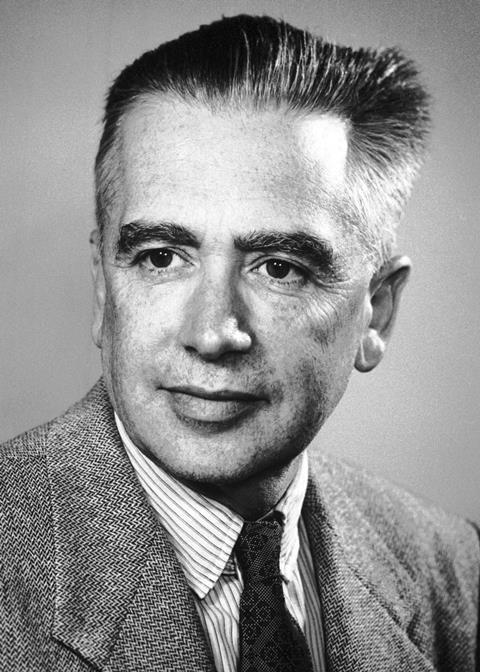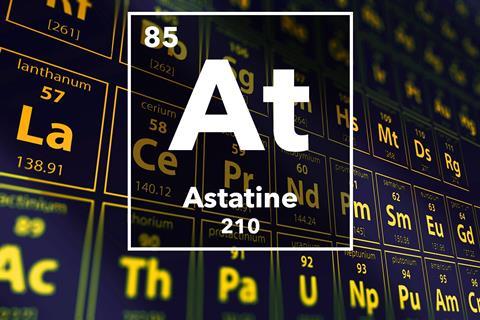Chris Smith
Hello, a record breaker is the star of the show this week as we meet the chemical whose name means unstable and which is in the famous Guinness book as the world's rarest elements, but some bright medical future turn this rarity into something in common use. The element is Astatine and to tell the story here is Mark Peplow.
Mark Peplow
You can learn a lot about someone by meeting their family and the same is true for the element. That's how we come to know so much about Astatine. Often trumpeted as the rarest naturally occurring element in the world, it's only by extrapolating the properties of the other members of the halogen family, fluorine, chlorine, bromine and iodine the scientists could even begin to look at their obese sibling.
Astatine was the second synthetic element to be conclusively identified just three years after technetium, was isolated by Carlo Perrier and Emilio Segre of the University of Palermo. The element had actually been created in a cyclotron particle accelerator at the University of California in Berkeley where Segre spent the following summer continuing his research. But miles away from Italy Mussolini's government passed anti Semitic laws which barred Jewish people like Segre from holding University positions; so he stayed where he was, taking up a job at Berkeley and in 1940 he helped to discover Astatine along with Dale Corson, he was then a post doc and later went on to become President of Cornell University and grant student Kenneth MacKenzie. They bombarded a sheet of bismuth metal, that's two doors down from Astatine in the periodic table, with alpha particle to produce Astatine 211, which has a half life of about 71/2 hours and it neatly filled the gap in the periodic table just beneath iodine. Segre went on to become a group leader for the Manhattan project which built the first atomic weapon. And it was only once the Second World War was over that the trio proposed the name Astatine for their elemental discovery. It was from the Greek word meaning unstable.

Astatine is actually found in nature although it only appears as a minor spur on an obscure pathway in uranium fission. According to Greenwood and Earshaw, the Bible of inorganic chemistry, it's been estimated that the top kilometre of the earth's crust contains less than 50 mg of Astatine making a Guinness world record's rarest element.
Astatine is the least reactive of the halogens but just like the rest of them it combines with hydrogen to make hydrogen astatide which dissolves in water to make hydroastatic acid; it is just like a weaker version of hydrochloric acid. If you could ever isolate enough of this stuff astatine would be an even darker purple solid than iodine. Overall there are more than 30 isotopes of the element, all radioactive with the longest lived having a half life of just 8 hours.
You might think that something so rare would be completely useless, but perhaps not. Several groups of scientists believe that Astatine 211 could be used to treat certain types of cancer.

Radioactive Iodine 131 is already used to treat Thyroid cancers for example, because it preferentially accumulates in that organ. This concentrates the dose of radiation and it reduces the exposure of healthy tissue. The trouble is that Iodine 131 like many other therapeutic radioisotopes emit beta particles, fast moving electrons which can penetrate through a few millimetres of tissue. That makes them ideal for tackling substantial solid tumours, but not for the small clusters of cells, because the energy from radioactive decay is spread far outside the boundary of the tumour. Another form of radioactive decay, alpha particles would be much more suitable because these bulky clusters of 2 protons and 2 neutrons, effectively helium nucleus, can only travel about 50 micrometers in tissue. Astatine 211 is not only an alpha emitter, it has also got a very short half life and the fact that it decays to a stable non-radioactive isotope of lead means that the radiation dose is quite brief. It even has a secondary decay pathway that creates a few x-rays which doctors could use to track exactly where the isotope is in the body. The key challenge is though to connect the radioactive Astatine atoms to a molecule that will seek out specific cancer cells; then to the chemistry as soon as possible before the radioactivity decays away and to make sure that the Astatine doesn't fall off its targeted molecule once it is injected into the body. This may of course take decades of research to achieve but chemists have already identified rapid ways to make these Astatine complexes and there has even been a small but very promising clinical trial at Duke University in North Carolina, testing Astatine radiotherapy in 18 brain tumour patients. So if Astatine does become a successful medicine there's every chance that the rarest element might become surprisingly common.
Chris Smith
Mark Peplow, telling the tale of the world's rarest element. Well from rare to lethal now and especially if you're a monk.
Phillip Ball
Valentine admitted that antimony was poisonous. In fact he offered an apocryphal explanation for the name, saying that it derives from anti-monachos, meaning anti-monk in Latin because he once unintentionally poisoned several of his fellow monks by adding it secretly to their food in an attempt to improve their health.
Chris Smith
Phil Ball who will be bringing Antimony to life for us in next week's Chemistry in its element. I'm Chris Smith, thank you for listening. See you next time.













No comments yet